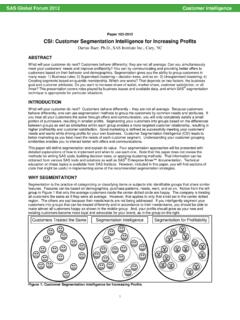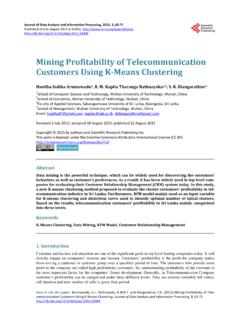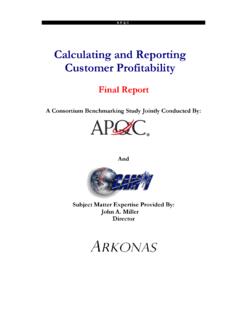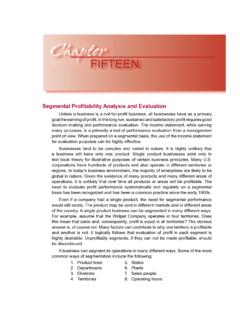Transcription of Customer Stratification: Understanding Customer Profitability
1 1 Abstract Number: 007-0065 Abstract Title: Customer stratification : Understanding Customer Profitability Author Information: 1) Arunachalam Narayanan Department of Industrial Distribution, Texas A&M University MS 3367, TAMU, College Station, TX, 77843 979-845-1462 2) F. Barry Lawrence Department of Industrial Distribution, Texas A&M University MS 3367, TAMU, College Station, TX, 77843 979-845-1463 3) Brijesh Rao Department of Industrial Distribution, Texas A&M University MS 3367, TAMU, College Station, TX, 77843 979-847-9074 4) Pradip Krishnadevarajan Department of Industrial Distribution, Texas A&M University MS 3367, TAMU, College Station, TX, 77843 979-458-3029 2 Customer stratification : Understanding Customer Profitability Abstract.
2 Classification of customers into groups based on Profitability and volume is an essential step in developing a Customer -centric operations strategy. Our technique stratifies customers into four different groups such as Core, Opportunistic, Marginal, and Service-drain. Core customers are profitable customers who transact in high volume on a regular basis. Opportunistic customers are also profitable customers who buy infrequently when their regular supplier stocks out. Marginal customers buy infrequently in low sales volumes and require either low prices or high service levels.
3 Service-drain customers are high volume customers who consistently require higher levels of service while demanding low prices. In addition to developing the stratification technique, we also recommend strategies to handle each of those Customer segments in terms of pricing, negotiation, and resource allocation. We will demonstrate this technique and its application using data from an industrial distributor. Keywords : Customer stratification ; Customer classification; Pricing; Customer service strategy 1 Introduction Traditionally, distributors have acted as middle-men in their supply chains, but lately they have taken the role of marketing and information managers.
4 The authors have been working with industrial distributors in United States for over a decade and have helped several key players with their inventory management. Over the years, pricing has become a key area of focus. Distributors are being pressured to reduce prices for the 3 customers, but they still have to maintain their profit margins to stay in business. Customers expect reduced lead times and better services, but at the same time, refuse to pay for the additional services. As a result, distributors are seeing a compression of their margins (Lawrence, 2006).
5 This prompted the researchers at Texas A&M University to start a consortium of distributors, manufacturers, and service providers to study the distributor s pricing problem. In spring 2006, nine key players in the industrial distributor supply chain with collective revenue of over $4 billion joined the consortium. They provided both funding and data to conduct the research. Weinberg (1975), Stephenson et al. (1979), Joseph (2001), Lal (1986) and Bhardwaj (2001) have all raised the popular question in pricing: should pricing decisions be made by the company or should significant leeway be provided to the sales force?
6 Mishra and Prasad (2004) also address the same question under imperfect information ( , when the salesperson s knowledge of the customers differs from the company s knowledge). The researchers at Texas A&M University also encountered the same dilemma at the focus sessions with consortium partners. After initial sessions, the consortium members identified some key issues in pricing. These were Customer types, product status, and services. The question of pricing at company or sales force level was identified as a secondary factor when compared to the above-mentioned key issues.
7 As a result, there was a need to identify the types of customers. Campbell and Cunningham (1983) categorize customers into four groups: yesterday s customers, today s regular customers, today s special customers, and tomorrow s customers. They base this classification on multiple criteria including sales volume, age of relationship, and Profitability . This classification however did not fit the 4 objectives of the pricing consortium. The authors are unaware of any other literature that addresses multi-criteria Customer stratification . Therefore, the first step for the consortium was to develop a methodology to stratify customers in the industrial distribution sector.
8 Inventory and Customer stratification Companies typically use stratification techniques for inventory management. These techniques are commonly known as ABC inventory analysis. According to a recent study conducted by Aberdeen Group (2004) of firms generating over $1 billion in revenue, 60% still use ABC classification or similar strategies to set their inventory policies. This technique is based on Vilfredo Pareto s observation (Pareto, 1906), which is widely known as the 80-20 rule or the law of the vital few. Pareto observed that about 20% of the population of a country has about 80% of its wealth.
9 This rule holds true for items sold by a firm: about 20% of items account for about 80% of a firm s revenue. Inventory stratification determines which items need to be stocked and which items need to be carefully monitored using effective forecasting methods. It also helps establish appropriate service levels for items in each class. Inventory stratification typically identifies fast moving, slow moving, profitable, and unprofitable items. The technique classifies items as A, B, or C based on certain threshold conditions. The most popular criterion used in inventory stratification is the sales volume.
10 Combinations of multiple criteria have also been used for inventory stratification . These include combining item criticality with dollar usage (Flores and Whybark, 1989), and combining cost of goods sold, number of transactions, and Profitability (Schreibfeder, 2005). 5 Various other criteria could be included in the stratification process based on the business environment, data availability, and management strategies. In this paper we extend the idea of stratification to customers. It is well known that revenue and profits from customers follow Pareto s rule about 20% of a firm s customers account for about 80% of its revenue and profits (Curry and Curry, 2000).













